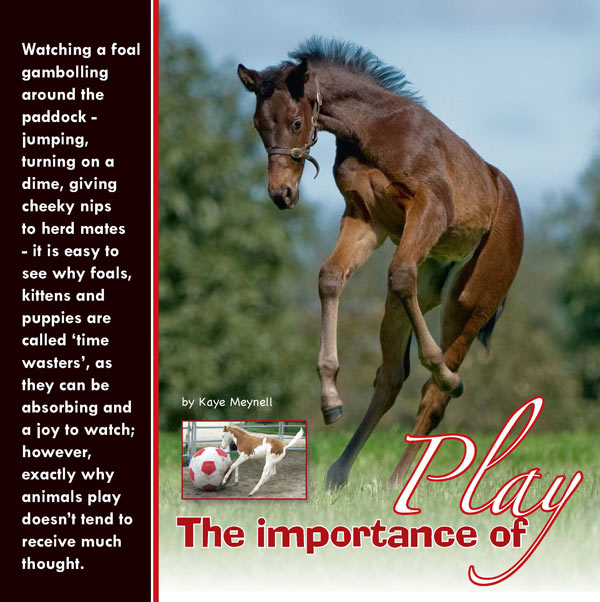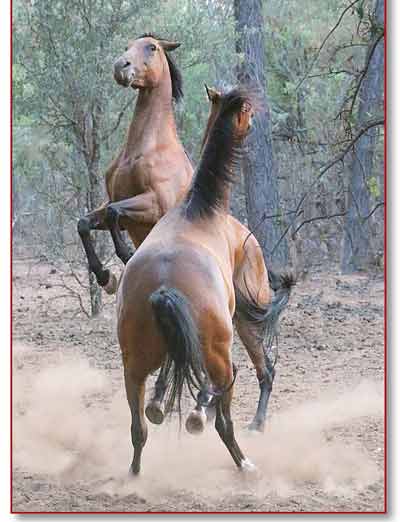|

Play behaviour in horses is an area that has, until relatively recently, received little attention from the scientific community compared with the study of other behaviours, such as aggression and feeding habits. Perhaps this is because play was historically considered not ‘serious’ enough to warrant thorough investigation – as opposed to other behaviours that may directly affect body condition/survival rates or breeding success (in feral horses at least). Whatever the reason, how and why horses play has only recently begun garnering significant interest from ethologists (Ethology is the science and objective study of animal behaviour - especially under natural conditions), and there are still many questions to be answered.
WHY DO HORSES PLAY?
It is common to observe young mammals playing; almost everybody will have, at some point in time, witnessed a kitten, puppy, foal or lamb engage in a bout of playful behaviour, whether alone or with another animal or a human. In fact play does not stop at mammals - there are reports of other animals such as fish and birds engaging in play too. In equines, play begins when a foal is just weeks old and is often carried out with the foal playing with objects rather than other youngsters, though they may involve their dam. Whilst play is observed more frequently in young mammals and birds it is seen in adults, though to a lesser extent. The problem however is that there is currently no consensus as to the reason (or reasons) behind it. In fact, both the short and long term benefits of play have yet to be clearly defined and agreed upon by those studying it, and whilst there are a number of theories presented, play is likely to serve several functions.
Two of the more well-known theories are that play is carried out in young animals as a way of ‘training’ their musculoskeletal systems for the rigors of adult life as a prey animal that relies on fight or flight mechanisms, and that play helps build social relationships – both of which ultimately improve an individual’s chances of survival.
Another more recent – and very different - view is that play (in adult horses at least) can be an expression of chronic stress (Hausberger et al., 2012). This is in agreement with some findings in other species where play is seen to arise in a bid to prevent social tension or competition for a resource. It is therefore desirable from a management and welfare point of view, that play behaviour in young and mature horses is studied in greater detail.

DOES PLAYING ‘TRAIN’ THE MUSCULOSKELETAL SYSTEM?
The ‘physical training’ theory is that during play bouts, young horses perform particular movement sequences that mimic - to varying degrees - those they will need as an adult (e.g. a stallion mounting a mare, or a horse fleeing from danger). Since play accounts for a large portion of a foal’s physical activity, those in support of this theory propose that it is this repetitive activity that is important for conditioning the musculoskeletal system, and that the movement patterns used in play often simulate (but exaggerate) normal movement patterns. (Graham et al., 2010). In other species, object play is thought to perhaps help with the development of coordination, and in horses it is believed to be related to feed handling and obtaining information about the horse’s immediate environment.
A study by Cameron et al. (2008) observed feral horses engaging in object play, sexual play, locomotor play, and play fighting. They reported that whilst male foals initiated more play bouts than females and were more likely to play with a partner, there was no difference in the overall time spent playing between the sexes, although males did tend to spend more time play fighting.
The differences observed between male and female foals led the authors to conclude that play does appear to serve as social training or as a means of refining particular motor skills that will be needed later in life, which differ between the genders since, for example, fighting success can be linked to reproductive success in stallions. In this study – which set out to assess the influence of the level of nutrition the mare provided the foal on play behaviour - they demonstrated that mares that invested more in their foals had foals that played more. In order to rule out any variation between individual mares that could explain how foals behaved, the authors compared mares who’d had colts and fillies in different years. Interestingly this was only true for male foals; the colts of mothers in good condition played more than the fillies of the same dam, whereas it was the fillies of mothers in poor condition that played more than their male siblings. Also reported was that those foals that played more (both fillies and colts) had a better survival rate, and a better body condition as yearlings. This was despite the fact that these foals weaned at a younger age.
The authors suggested that dams in good body condition will invest more in a colt than a filly because a highly successful colt can outcompete a highly successful filly (i.e. produce more offspring in its lifetime), and conversely mothers in poor body condition will invest what they have more in a filly - since most female horses that reach adulthood breed at least once in their lifetime, whereas an unsuccessful male may never breed. That increased maternal investment boosts the physical development of a foal might mean that the mare’s offspring can begin breeding earlier, thus maximising the amount of progeny they produce over their own lifetime (and thus the transfer of the dam’s own genes).
ADULT PLAY
An issue with the theory that play is ‘training’ for the musculoskeletal and cardiovascular system, and increases strength and endurance, is that it does not explain why adult horses play, as one would expect these skills/movements would already be honed in a mature animal. An example is geldings, which are often observed to play fight and engage in sparring with each other. An interesting theory put forward by Chiszar et al. (1985) is that mature animals may play with infants in order to assess or assist offspring development!
On the flip-side, one might ask the question that if play functions to improve strength/endurance, why then do adult horses play so infrequently, as surely these qualities would require ongoing ‘conditioning’ throughout the life of the horse in order to maintain them?
PLAY ASSISTS IN THE DEVELOPMENT OF SOCIAL SKILLS AND RELATIONSHIPS?
As a larger body size does not always mean a greater breeding success Cameron et al. (2008) argue that increased maternal investment might serve not to ensure foals grow bigger, but to give them the energy to play more, which enhances their physical and social development.
Horses are highly social prey animals that have evolved to exist in herds, with an established hierarchy and clear leaders and followers. In this respect, it is thought that social play (two or more players) may assist horses with the development of social skills such as courtship (the relationship between mares and stallions in a herd can determine breeding success), respect of rank and herd hierarchy, companionship (e.g. mutual grooming) and learning to avoid conflict – all of which can enhance their social relationships. In their paper The Biological Study of Play (2010), Graham and colleagues state “Maintaining social play requires that players be highly attuned to the rapidly changing nature of the play bout. Players must read social cues appropriately, react swiftly and accurately to movements, and anticipate responses.”
Due to the different social roles that adult male and female horses evolved to fulfil in the herd, this theory would propose that sex differences in play behaviour will be observed, and this was confirmed by Cameron and colleagues who saw that male foals spent more time engaging in play fighting.
The findings of studies looking at play behaviour can be contradictory, which adds to the difficulties in agreeing on its function. For example, some work in rats showed that a lack of social play during development leads to cognitive and behavioural insufficiencies later in life, whereas other studies in which mammals were deprived of the opportunity to play, reported that adult skills such as mating and fighting continued to develop normally (Graham et al., 2010).Since some research has shown that play fighting never completely mimics the real life scenario, and because a motor skill can only be ‘practiced’ properly if the exact same motor pattern is undertaken, it is argued that play fighting in a young animal will not help enhance fighting tactics.
Some researchers have suggested that peak play periods correspond with particular developmental periods in animals (social, hormonal and physical) though this is challenged by others. Another theory is that play is purely a means of burning off extra energy.
COSTS VS. BENEFITS
It is claimed that animals such as horses, whose play behaviour pushes their muscles, tendons, ligaments and bones to the limit, increase their risk of injury and therefore death. In addition, an animal playing is one that is sacrificing feeding opportunities –possibly compromising health – and making itself more visible to predators (important in a prey animal such as the horse). However, whilst the benefits of play currently remain unknown to any degree of certainty, if there were no benefits gained by playing to outweigh the risks, one would expect that the behaviour would have been extinguished years ago as a result of natural selection.
PREVENTING PLAY
As with many other behaviours that horses are prevented from expressing simply due to the modern way in which they are managed – e.g. the prevention of continuous foraging due to restricted turnout – humans often limit play behaviours in horses due to the fear of injury and because they (incorrectly) believe that the repetitive movements and sequences expressed during play will cause stable vices.
Some owners try and provide environmental enrichment for horses that have limited or no opportunities to socialise (and play) by providing stable/paddock toys, however social play with other horses should be encouraged whenever possible. In their book ‘The Domestic Horse’, authors Daniel Mills and Sue McDonnell caution that preventing play between horses can in some cases cause more problems, especially as many horses will be seen to engage in explosive play bouts when finally turned out with other horses. If this takes place in horses that have no experience of play to guide them in reading other horse’s behaviour, this can result in injury they say.
Since the study of play behaviour often seems to raise more questions than it answers, it is clear that there is some way to go before play in horses is understood fully, and though research in this field is becoming more popular, and the rise of social media and the internet means more anecdotal evidence is being shared and gathered, there remains many difficulties with studying play in both feral and domestic horses. |